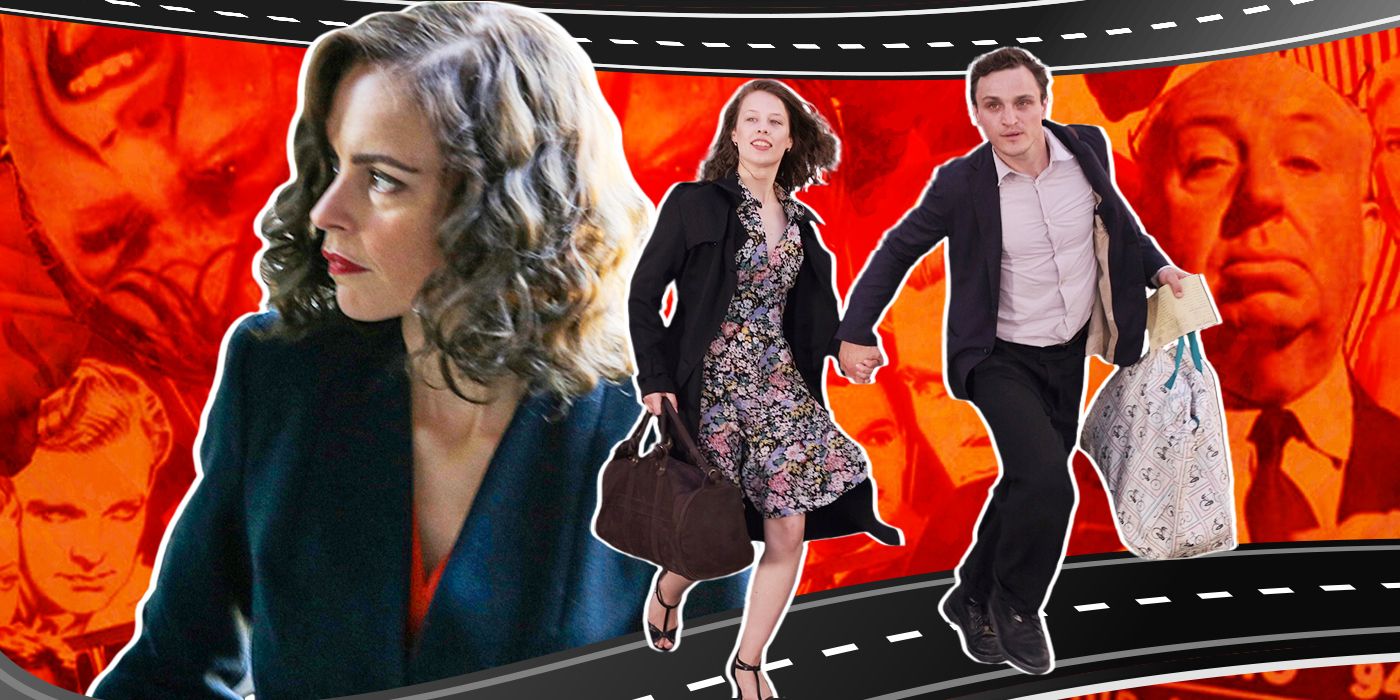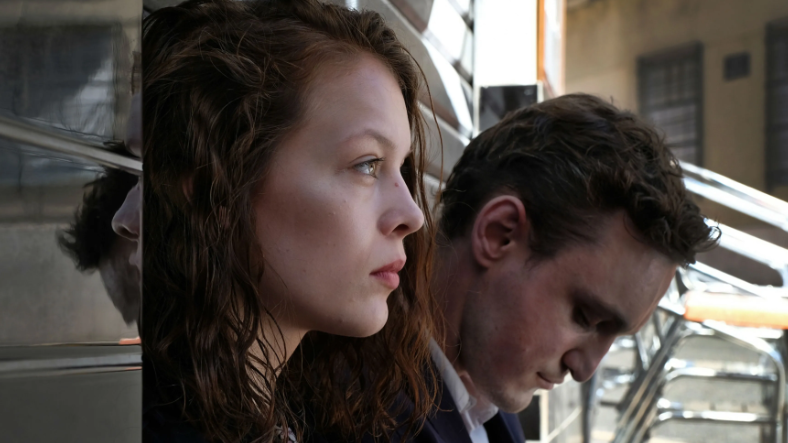Throughout his critically acclaimed films Phoenix and Transit, Christian Petzold demonstrates the Berlin School’s return to genre filmmaking by fusing generic tropes with a neorealist visual style.
Phoenix references various genres, but most prominently the Hitchcock thriller, within Nelly’s (Nina Hoss) narrative through evocative historical imagery. This provided a space for navigating personal trauma and collective emotions in late 1940s Berlin. Through her reconstructive surgery and spectral self-impersonation for Johnny (Ronald Zehrfeld), Nelly’s acts of self-replacement become emotional embodiments of wartime trauma on the female body, inverting the plot of Alfred Hitchcock’s Vertigo to adequately accommodate for Johnny’s financial and emotional exploitation of the protagonist.
In contrast to the meticulous re-historicization of Vertigo in Phoenix, Petzold’s Transit engages the tropes of Hitchcock’s “wrong man” thrillers within an atemporal dystopian context existing between the political fears of World War II Europe and contemporary visual signifiers like modern cars and clothing, critiquing the historical cycles of wartime anxiety through Georg’s (Franz Rogowski) attempt to flee France after a fascist invasion. By comparing the two manifestations of revisionist historical storytelling through the lens of thriller tropes, Petzold provides a haunting contemporary analog to the iconic suspense-driven cinema of Alfred Hitchcock, mobilizing the use of Hitchcockian narrative structures to comment on isolation in the face of advancing technology and human connection in eras of political oppression.
Evoking the ghostly imagery of the skeletal final image of Hitchcock’s Psycho and especially the Hitchcockian body horror of Henri-Georges Cluzot’s Eyes Without a Face, the opening scene of Phoenix introduces Nelly wrapped in bloodied bandages, establishing the film’s emphasis on the bodily impact of postwar trauma. As Lene returns Nelly to Berlin after her liberation from Auschwitz, the shadowy nighttime cinematography visually expresses the spectral force of postwar pain hanging over the film, emotionally aligning the audience with Nelly’s grief as she returns home to confront her physical and emotional trauma. After Lene and Nelly surrender their passports to a guard for inspection, the camera showcases the soldier’s point-of-view, revealing Nelly’s blood-covered bandaged face. While the image immediately stirs fascination with the person beneath the gauze, the visualization of Nelly’s bandaged face initiates the film’s engagement with voyeuristic suspense, emphasizing a Vertigo-like intrigue into Nelly’s identity and gendered experience that the film explores through Nelly’s restorative surgery and performative relationship with her former husband Johnny.
Following a brief period of initial readjustment after a restorative facial surgery, Petzold intensifies the intertextual invocation of Alfred Hitchcock’s Vertigo through Johnny’s attempted exploitation of Nelly in order to receive her inheritance. After an evening of work at the Phoenix nightclub, Johnny quickly takes Nelly back to his home through the shadowy streets of Berlin. Upon arriving at his basement apartment, Johnny confesses that he needs Nelly to impersonate “his wife” in order to receive her inheritance, instigating the film’s dialogic homage to Vertigo. While Hitchcock waits until the final act of the film to reveal to the audience that Judy and Madeline are the same person, Petzold inverts Vertigo’s story structure to reveal Nelly as Johnny’s wife in the film’s first act before Johnny himself discovers it, placing the audience at an emotional advantage with the knowledge of Nelly’s survival. By disclosing Nelly’s survival to the audience before Johnny, Petzold reverses the thriller genre’s emphasis on prolonging mystery for the audience in order to undermine Johnny’s patriarchal position within the narrative.
Nina Hoss’s performance of Nelly’s trauma through subtle slouches and slight stumbles as she takes on her pre-war clothing and mannerisms exemplify the bodily effects of trauma. Nelly’s embodiment of wartime pain within the homage to Vertigo demonstrates how Petzold’s inversion of the thriller genre reinterprets Hitchcockian suspense as a method of ambiguous historical catharsis. While Johnny’s lack of acknowledgment for Nelly’s true identity and experiences of personal pain aligns Nelly alongside Kim Novak’s character(s) in Vertigo, Nelly transcends Judy’s complacency through her active undermining of Johnny’s attempted exploitation through her subversive self-impersonation.
After her formal “reentry” into postwar life, Nelly’s final performance of the song “Speak Low” provides the protagonist with an emotional and physical liberation from Johnny. When Nelly asks Johnny to play “Speak Low” for her to perform for their friends, a glimmer of recognition and guilt appears in Johnny’s visage, revealing his failure to recognize Nelly’s true identity. In the middle of Nelly’s performance of the song, a point-of-view shot shows Johnny’s perspective of Nelly’s tattooed arm, revealing Nelly’s identity to Johnny. Immediately, Johnny stops playing the piano as he processes his guilt and sole complicity in the manipulation of his wife, indicating Johnny’s misogyny through Nelly’s revelation. After concluding her performance of “Speak Low,” the film’s final shot displays Nelly’s confident acknowledgment of her audience and departure from the performance space, ultimately expressing self-recognition rather than self-impersonation. Nelly’s liberation subverts the ending of Hitchcock’s Vertigo, as Nelly outlasts Johnny rather than dying in his stead like Judy.
If Phoenix uses the Hitchcock thriller as a cinematic rhyme scheme with Vertigo, Transit reframes Hitchcock’s “wrong-man” trope as a non-sequitur, transforming Georg’s impersonation of a dead writer in order to secure transit papers into a tale of immobility and historical cycles. Although many non-Hitchcock films, including Casablanca and Michelangelo Antonioni’s mistaken identity anti-thriller The Passenger, paved the way for Transit’s examination of the absurdity of wartime relationships and the risks of false impersonation, respectively, Transit also boldly upends the crime thriller trope of the “wrong man” through Georg’s circumstantial dodging of punishment as he impersonates a politically subversive writer named Franz Weidel. Rather than engaging Georg’s perceived criminality as a location for narrative suspense, Petzold positions him as a pawn in a timeless political game, transposing the wrong man character structure of Hitchcock’s North by Northwest or the aptly titled The Wrong Man into an individual completely lacking agency within the wartime systems. Even as Georg develops a romance with Weidel’s former wife Marie (Paula Beer) after dishonestly securing the couple’s transit papers for himself, the film never veers into a suspense-building, focusing instead on Georg’s interiority as he encounters each seemingly predetermined experience.
Beyond the narrative level, the Hitchcockian power of Transit primarily flows from the spring of ambiguity in the film’s timeless and placeless setting as well as Petzold’s withholding of essential information. Even as the story seems to evoke the sociocultural woes and growing political conflicts that instigated World War II, Transit applies the historical structures to ahistorical settings, littered with both ancient buildings and modern transportation. By blurring the temporal lines of the film, Petzold enhances the mystery of Georg’s ironically immobile journey, placing him into a larger network of circumstances beyond his control. Georg’s role as a reinterpretation of the wrong man establishes the protagonist as a person capable of revealing the truth regarding an intentionally mistaken identity. Rather than revealing the mystery in the conclusion in a manner similar to Hitchcock’s work in the production code era, Petzold extends the Hitchcockian tropes into a more ambiguous realm of anti-thriller antics. Transit even concludes with the clever inclusion of Talking Heads’ “Road to Nowhere” playing over the credits, which finalizes the Hitchcockian absurdism of Georg’s predestined journey towards an undefinable, and perhaps undiscoverable, place of freedom.




